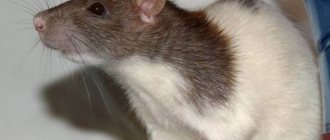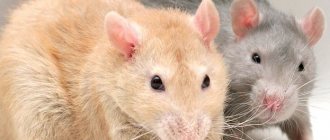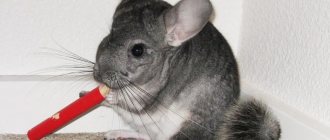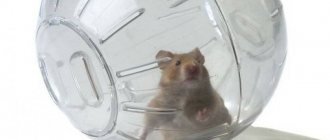Rodents are often kept as pets for children. But rats are one of those animals that quite adult, adequate people willingly keep at home. Simply because they fell in love with these animals. Before buying a pet, you should weigh all the pros and cons of pet rats. A living being is a great responsibility. Perhaps, after reading this article, you will prefer to get another rodent (for example, a guinea pig) or even wait until “adding.” I became infected with rat mania as a child. Although there are no rats living in my house now, I still hope that the children will grow up and help me persuade my husband to get a couple of rats. I promise to tell you about the disadvantages of decorative rats. After all, rave reviews from rat breeders on the Internet are not very helpful. It is the shortcomings and content issues that should be of interest to a beginner in the first place. Well, if they don’t scare you, welcome to the society of rat lovers.
Author of the article: Olga Shiltsova, practicing veterinarian, author of the books “Dachshund of Fate” and “Tails of Fortune”
Benefits of rats as pets
Gone are the days when, when hearing the word “rat,” a person remembers with horror the wild gray bee – a source of disease, a devourer of livestock feed, a thief and a pest. Decorative (“laboratory”) rats have gone far from their ancestors and have firmly won their place among pets. Fair enough, because rats have a number of undeniable advantages.
High intelligence
Rats are so intelligent that humanity should be scared. People have previously paid attention to their uncanny ability to avoid poisonous bait, deftly empty rat traps and transmit information to each other. Scientists are now confident that rats have a sense of humor and abstract thinking - almost like humans. They have their own language. When communicating with each other, they use several thousand different sounds and gestures. What does this mean for the rat owner? What will be interesting with a pet. A rat can be trained - no less successfully than a dog. Even if you don’t specifically engage with the animal, they begin to respond to the call and remember some words. My rat quickly learned to open the cage on his own, jump onto his shoulder at the snap of his fingers, and run out into the middle of the room to the sound of his fingers tapping on the floor.
Let me boil the owner’s kettle, he looks tired!
Affectionate, contact
Most people love rats not for their remarkable intelligence, but for how cute they are. Soft, warm, affectionate. Rats are easily tamed; they themselves seek communication with humans. Your pet rat will willingly crawl inside the sleeves of your sweatshirt, and even sleep lounging on your neck. Some rats like to kiss - lick their owner, tickling them with their whiskers. Mutual grooming is natural for them, so the animal can not only lick you, but also bite you, scratch you with its claws, and get tangled in your hair. Domestic rats are absolutely not aggressive. They do not bite their owners. The animal can defend itself if it is very frightened or in pain. But in my practice, rats only squeaked pitifully during injections or removal of sutures, without making any attempts to bite the hands that held them.
It's interesting to watch them
The third logically follows from the first two points. Intelligent and social animals are amazing things to watch. It is recommended to keep rats in same-sex communities (possibly opposite-sex only if the animals are castrated). If there is more than one rat at home, you will see many funny scenes. But you can also give your pets something special to do - hide treats, build labyrinths and climbing complexes. Children and teenagers especially love to do this, forgetting even about the computer and other gadgets.
Easy to care for
Caring for a rat is not difficult; it can be entrusted to children. The main thing is timely cleaning of the cage and replacement of the filler. Feeding does not take much time, and is perceived by owners more as entertainment than as a duty. You don't need to walk the rat outside, you don't need to wash it. There is no need to comb the fur or trim the nails. The animals cope with all this on their own.
Caring for a decorative rat from A to Z (will open in a new link)
You can take it with you
Due to their small size, transporting a rat is a simpler task than transporting a cat or dog. Many people smuggle rats without notifying the train conductor. For trips to the veterinary clinic or to the country, it is worth getting a special carrier. I even took the rat to school, where it sat in my pocket, in my arms or in my briefcase. Although now it seems to me the height of irresponsibility. But the fact remains that rats are small and inconspicuous. Which allows you to keep them even in a dorm room.
In any unclear situation, go to bed!
Doesn't make loud sounds
Rats are naturally inclined to live secretly. They communicate largely through smell, and all the sounds they make are quite quiet. The only exception is a high-pitched squeal or squeak at a moment of extreme fear or pain. A rat can only make noise when it is actively digging through bedding or chewing on something hard. Although most owners find these sounds not annoying, but calming. Rats are quiet, which distinguishes them from guinea pigs, which whistle among themselves and also demand food with a deafening whistle.
Varied appearance
When I was a child, they sold mostly white albino rats and black-and-white “hooded” rats. Now there is a huge variety of colors among decorative rats. Despite the fact that part of the population retains the “wild” gray-brown color, which is called agouti.
The agouti-colored rat most closely resembles its ancestor, the pasyuk.
Rats can be a solid color or have beautiful white markings. Black, blue, chocolate, beige. There are even color-point rats (“Siamese”).
Fawn rat
The animals also differ in the type of fur they have. The most common are smooth-haired rats. But breeders have already bred naked-skinned rats - sphinxes, rats with wavy fur - rexes and long-haired rats. There are also rats with a special shape of ears - dumbos. These animals are incredibly popular, their round ears are larger than those of ordinary rats, and they are located not at the top, but on the sides of the head.
Naked sphinx rat
What will you need for the injection?
For injection, you need to prepare a syringe (preferably an insulin syringe, with a removable needle).
The owner of a rodent should keep a supply of disposable insulin syringes in his home medicine cabinet.
Injections to an animal can be done with the same syringe several times, just store the accessory in a clean place. Instead of an insulin needle, you can use a butterfly needle, the size is important - rats need blue (size 23G) and orange (size 25G).
Cons of decorative rats
Before you bring a little rat into your home, think about whether you are ready to accept him with all his shortcomings. The amount of responsibility does not depend on the size of the pet. Pay attention to the disadvantages of decorative rats.
Short life expectancy
On average, rats live 2-2.5 years. With good care and heredity - 3-3.5 years, no longer. Parting with a smart and affectionate pet is unbearably difficult. This is the main disadvantage of rats - they live only a little longer than hamsters. But with a hamster, the owner usually does not develop a deep emotional attachment. Other rodents and lagomorphs - rabbits, guinea pigs, chinchillas and degus - live much longer than rats.
Rat "Siamese" color
Urine marks, feces
Although rats themselves are clean animals, they cannot be toilet trained like a cat or hamster. Peeing everywhere is necessary for them, this is how they mark their territory. I'm not sure about feces, but they poop wherever they want. Accordingly, after a walk you need to remove the “gifts”. When a rat crawls over a person, it can mark him too (pee).
Destroy things and repair
Call Captain Obvious, rodents are gnawing! Rats have incredibly strong and sharp teeth, allowing them to crush even concrete. Keeping smart animals in a cage all the time is cruel; they have to be let out to run around. And some damage is inevitable. Before a walk, you need to hide all things dear to your heart - documents, headphones. Rats chew curtains, wallpaper, books. My rat secretly chewed a round hole in the wooden bottom of the sofa, and made a luxurious nest in the quilted blanket that lay inside. I discovered this only in winter, but I was still surprised - where is he hiding for so long?
You need to decide in advance what you love more: rats or furniture
Poor health
Stories about the incredible vitality of rats cause them a lot of harm. People think that rats are “unkillable”, which means they can be fed everything, parachuted from a bunk bed, or allowed to swim in the bathtub. Firstly, you cannot compare the health of a wild pasyuk and a decorative rat. Secondly, the vitality of rats is primarily the well-being of the entire species, and not the individual. They have gained a formidable reputation for their extremely rapid reproduction. And fertility does not mean good health, rather the opposite. Rats catch colds easily, may suffer from digestive disorders, and get injured while walking. But the main thing is that they are susceptible to cancer. Their tumors grow rapidly and require immediate surgical intervention. The situation is complicated by the fact that only a small number of veterinarians are able and willing to treat rats. There is not a special doctor - a rodentologist - in every city. It is better to find out his contacts in advance from rat breeders or on rat breeding forums.
Read about how to properly feed a rat HERE (link will open in a new tab)
Curly mustache of a rex rat with wavy fur
May be noisy at night
In nature, rats are active at dusk and at night. Domestic rats often adjust their routine to suit humans, but still tend to be active at night. They can chew the metal bars of the cage and household items in it, and dig into the bedding. Consider this point - if the slightest noise prevents you from falling asleep, there is no place for a cage with rats in the bedroom. But children are usually not bothered by this night fuss, and they sleep peacefully next to their favorite pets.
The smell from the animal and from the cage
Many people even consider the smell from a clean and healthy rat to be pleasant. But in order not to smell the unpleasant smell from the cage, you will have to work hard. It is necessary to choose a good filler and change it regularly. Wash and clean the cage. Remove leftover food. The more rats, the more often cleaning is required. In addition, rats can piggy - scatter food and litter around the cage.
For most rat breeders, the animals walk freely around the room, returning to the cage at will. The larger the cell, the less likely it is that an unpleasant odor will occur.
Negative attitude of others
You should be prepared for the fact that some of your friends will stop visiting your home because you keep rats. Some people cannot stand their appearance, experiencing a feeling of disgust or fear. A phobia can be causeless and innate, like the fear of spiders. Or it may be associated with a traumatic experience of communicating with wild rats. My grandmother had one, and although she admitted that my pet had a cute face, she could not see his tail without shuddering. You can't force other people to like rats. Most likely, you will encounter cruelty and misunderstanding during the illness or death of a pet (“it’s just a rat”). You will also listen to lectures on the plague and other horrors associated with rats.
Plague on your home! Rat tails can be terrifying
Description of the animal
Rats belong to the class of mammals. Body dimensions can be up to 30 cm and weight 300 - 400 g. Animals lead a terrestrial lifestyle. In nature, there are rats that can climb trees. They live in burrows alone or as a family.
In addition to wild rats, there are also affectionate, caring domestic pets. Currently, many interesting decorative individuals have been bred. They communicate very well with people.
Among them it is possible to meet a unique animal without hair - the sphinx or, conversely, curly-haired animals. A rat can be tailless or have a flat tail and ears of different shapes.
A very interesting specimen is the Dumbo rat, whose coat colors can be gray, white or black. And the advantage is the ears. The larger they are, the more valuable the specimen.
The color of a rat is an important criterion when choosing a pet.
In China, Ancient Egypt and Japan, these animals were revered as sacred animals and lived in temples. It was believed that they could predict events.
Domestic rat: reviews
“I love both cats and dogs, but I’m not ready to keep them at home. But I have a special love for rats. This is my spirit animal or something. Creatures close to our hearts have gone to the rainbow many times already. Thanks to them, I learned to relate to death more easily.”
“My girls are just incredibly cute, despite their long hairless tails. I taught them several commands. My favorites are “circle” and “serve.” When I myself was eating something delicious, Sonya would run up and start spinning wildly in place so that she could be treated. Affectionate, curious, cheerful"
“I speak from personal experience – males are much more “fragrant” than girls. My Francis wrote everywhere. Notebooks and textbooks were stained with yellow, and clothes had to be washed every day. Mom was terrified. Well, of course he chewed up the furniture a lot. When he passed away, I was categorically forbidden to get a new rat. I still remember my first pet with tenderness.”
“In my opinion, rats are the only rodents that become attached to humans. They are also cunning, curious, clever thieves. They can bite – most often without understanding what’s what. That’s why you shouldn’t stick your fingers into the cage through the bars, and also don’t try to kiss if your breath smells strongly of food.”
“My rat lived for more than 3 years and weighed 700 grams. Calm and approachable, he was my favorite. He was not afraid of either a cat or a dog, but they respected him. He pulled out fluff from cats for nesting and stole dog food. Mr. Rat (we never gave him another name) walked freely throughout the apartment, voluntarily returning to the cage as if it were his home. There was no unpleasant smell from the cage, you just need to clean it more often! The breakup was hard, and this is the only reason I didn’t get a rat again.”
I strongly advise all rat breeders, present and future, to read the book by science fiction writer Olga Gromyko - “Rat Ratcats. The life of a rat in stories and pictures.” She conveys the characteristics of these animals amazingly and with humor.
Bathing and grooming
Decorative rodents are very clean and constantly look after themselves. But at the same time, they are constantly in a contaminated cage with pieces of food and droppings.
The pet owner should follow some rules to maintain hygiene in the cage:
- dry granules or large sawdust shavings are best suited as bedding for a rat; small ones can get into the rat’s eyes, and it will develop an allergy;
- no need to use newspaper as a lining. When it becomes wet, harmful substances contained in printing inks are released, and this threatens the rodent with poisoning;
- the cage needs to be cleaned every two to three days;
- Once every two weeks it is necessary to disinfect all toys and devices; there are special preparations for this.
Rats can and should be bathed. Usually they love it, but it happens that the animal refuses to bathe. In this case, there is no need to force the rodent into the water and wet it - you will help lose the trust of your pet. Those who do not like bathing at all should sometimes be wiped with wet wipes.
The only tricolor beauty
The second tricolor rat was born in 2006 and received the original name - Dusty Mouse Shabu-Shabu. This is an amazing baby that violates all previously formed concepts about the genetics of rodents. Its uniqueness lies in the fact that the wool is dyed in three colors. According to the marking standard, this animal has a champagne hood color. The tri-colored Shabu-Shabu rat has a champagne-colored stripe along its back, head and shoulders, and the rest of the body is white. But in addition to these colors, black spots are also visible on this original. Theoretically, this is considered impossible.
More than 40 types of markings and colors are known to professionals involved in breeding and keeping rats.
However, there is not a single individual that combines exactly three colors. Shabu-Shabu Dust Mouse's parents were champagne and black hoods. Nothing similar was observed in other litters of these parents.
Recently, rare white rats with red eyes have been observed. These are albinos. This white color and eye color indicate that they have problems with melanin production.











